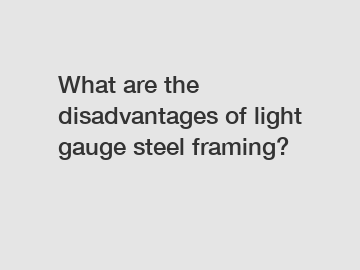What are the disadvantages of light gauge steel framing?
What are the disadvantages of light gauge steel framing?
Light gauge steel framing, also known as cold-formed steel framing, is a popular construction method due to its numerous advantages. However, like any construction technique, it also has its disadvantages. Understanding these disadvantages is essential for architects, builders, and homeowners to make informed decisions. In this article, we will explore the drawbacks of light gauge steel framing, their origins, the process of substantiating these disadvantages, and their significance and impact on the construction industry.
One of the main disadvantages of light gauge steel framing is its susceptibility to corrosion. Unlike traditional wood framing, steel is prone to rust when exposed to moisture, especially in environments with high humidity. This can compromise the structural integrity of the building over time. However, by employing effective corrosion protection measures such as galvanization or protective coatings, the risk of corrosion can be significantly reduced.

Another disadvantage is the higher upfront cost compared to wood framing. Light gauge steel framing requires specialized equipment and skilled labor for installation, which can result in higher construction costs. Additionally, the cost of steel itself fluctuates in response to market conditions, potentially making it less economical in certain circumstances. However, it is important to note that the long-term durability of steel can offset these initial expenses by reducing maintenance and replacement costs over the lifespan of the building.
Moreover, light gauge steel framing poses challenges in terms of insulation. Steel conducts heat and cold much faster than wood, making it a poor thermal insulator. Therefore, additional insulation measures need to be implemented to achieve the desired energy efficiency and comfort levels in the building. Although this can increase construction costs and complexity, advancements in insulation materials and techniques are mitigating this disadvantage.
Furthermore, the density of steel framing can hinder the installation of electrical and plumbing systems. Compared to wood, steel has less flexibility when it comes to drilling holes and making modifications during the construction process. This can result in increased labor costs and coordination challenges between different trades. However, careful pre-planning and coordination can overcome these obstacles, helping to optimize the construction process.
In conclusion, while light gauge steel framing offers numerous advantages such as strength, durability, and design flexibility, it is important to acknowledge and address its disadvantages. These include susceptibility to corrosion, higher upfront costs, insulation challenges, and difficulties in installing electrical and plumbing systems. Despite these drawbacks, advancements in protective coatings, cost-effective practices, insulation materials, and pre-planning strategies are continuously improving the performance and viability of light gauge steel framing in the construction industry. By weighing the potential drawbacks against the benefits, architects, builders, and homeowners can make informed decisions when considering this construction method.
For more information, please visit Light Steel Villa, expandable house, shipping container home from china.
132
0
0


Comments
All Comments (0)